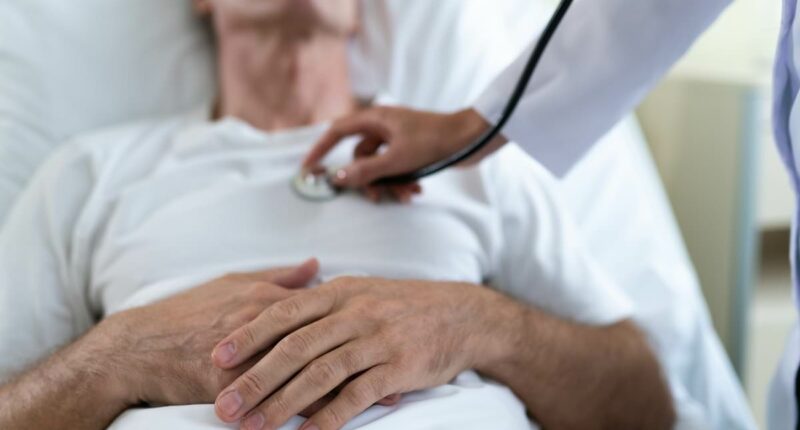Share this @internewscast.com
Recent research reveals a worrisome link between breathlessness and increased mortality risk in hospitals, indicating that those who experience shortness of breath are six times more likely to succumb while hospitalized.
Harvard Medical School researchers delved into data from almost 10,000 adult patients who faced breathing difficulties upon their hospital admission.
A significant majority, about 77%, of these individuals were admitted through the emergency department.
The study involved physicians asking patients to rate their level of breathlessness, known as dyspnoea, as well as their pain, on a 0 to 10 scale upon arrival and throughout their hospital stay.
Researchers monitored the patients’ outcomes over a two-year period, focusing on death, readmission rates, duration of hospital stay, and the requirement for intensive care services.
The findings highlighted a stark reality: patients who experienced episodes of breathlessness during hospitalization had a sixfold increase in the likelihood of dying while in the hospital.
Meanwhile, patients who reported experiencing shortness of breath upon arrival had a three-fold risk of dying.
Their analysis showed the higher patients rated their shortness of breath, the higher their risk of death.

A study has found that feeling short of breath at hospital increases your risk of death six-fold
Patients with shortness of breath were also more likely to need care from a rapid response team and be transferred to intensive care.
Even after discharge, breathlessness continued to predict poor outcomes. people who were breathless in hospital had a 50–70 per cent higher chance of dying within two years.
Experts have called for patients to be asked about if they are experiencing shortness of breath when they are admitted to hospital, as the quick check—which takes just seconds—could potentially save lives.
Study lead Professor Robert Banzett, from Harvard Medical School said: ‘Some patients experience it as feeling starved of air or suffocated.
‘In hospitals, nurses routinely ask patients to rate any pain they are experiencing, but this is not the case for dyspnoea.
‘In the past, our research has shown that most people are good at judging and reporting this symptom.’
In the journal ERJ Open Research, where the findings were published, the researchers wrote that hospitals should monitor if patients find themselves struggling with shortness of breath during their stay.
This they explained could ‘improve symptom management’ and help ‘identify patients at a higher concern’ who need more urgent medical attention.
Interestingly his study found that reported pain – which they also got staff to ask patients to rank – wasn’t linked increased death.
‘Pain is also a useful warning system, but it does not usually warn of an existential threat,’ said Professor Banzett.
‘If you hit your thumb with a hammer, you’ll probably rate your pain 11 on a scale of 0-10, but there is no threat to your life.
‘It is possible that specific kinds of pain, for instance in internal organs, may predict mortality, but this distinction is not made in clinical record of pain ratings.’
Professor Banzett added: ‘It is important to note that dyspnoea is not a death sentence.
‘Even in the highest risk groups, 94 per cent of patients survive hospitalization, and 70 per cent survived at least two years following hospitalisation.
‘But knowing which patients are at risk with a simple, fast, and inexpensive assessment should allow better individualised care.
‘We believe that routinely asking patients to rate their shortness of breath will lead to better management of this often-frightening symptom.’
Explaining, why shortness of breath may be a strong predicator of death, he said: ‘The sensation of dyspnoea is an alert that the body is not getting enough oxygen in and carbon dioxide out.
‘Failure of this system is an existential threat.
‘Sensors throughout the body, in the lungs, heart and other tissues, have evolved to report on the status at all times and provide early warning of impending failure accompanied by a strong emotional response.’
Reacting to the findings, Hilary Pinnock, chair of the European Respiratory Society’s Education Council, from the University of Edinburgh said: ‘It is interesting to read about the association of subject breathlessness with mortality and other adverse outcomes.
‘Breathlessness was assessed on a zero to 10 scale which took less than a minute to administer.
‘These noteworthy findings should trigger more research to understand the mechanisms underpinning this association and how the ‘powerful alarm’ can be harnessed to improve patient care.
Dr Cláudia Almeida Vicente, chair of the European Respiratory Society’s general practice and primary care group and a GP in Portugal, also not involved in the research commented on the findings.
‘Feeling short of breath can be a very unpleasant symptom and it can be caused by a variety of problems including asthma, a chest infection, chronic obstructive pulmonary disease, and even heart failure,’ she said.
Chronic obstructive pulmonary disease (COPD) is a group of lung diseases that cause breathlessness, wheezing and chest tightness – which are estimated to affect 1.7 million Britons.
She continued: ‘This study highlights how a simple dyspnoea rating can serve as a strong, early warning sign of clinical decline. New-onset breathlessness during hospitalisation carried especially high risk, far exceeding that associated with pain.
‘For inpatient teams, any rise in dyspnoea should prompt rapid assessment and closer monitoring.
‘From a primary care perspective, the elevated two-year mortality in patients discharged with dyspnoea signals the need for tighter post-hospital follow-up.
‘These patients may benefit from early visits, medication review and proactive management of cardiopulmonary disease.’ Cardiopulmonary disease is a group of conditions that affect both the heart and lungs.
‘A quick dyspnoea score offers powerful prognostic value and should inform both inpatient decisions and outpatient planning,’ added Dr Vicente.















